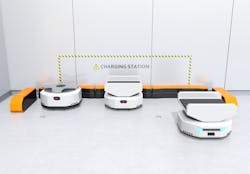Powering the next generation of robotic workers…without wires
By Gopal Mitra, industrial segment leader at ABB Power Conversion
The modern warehouse runs on robots. The past few decades have seen significant advancements in robotics and logistics, allowing futuristic warehouses to take shape. Within the walls of these facilities, robots automate nearly every function—from shelving and packing to distribution, cleaning and more. These robots have improved efficiency despite ever-rising customer demand, helping businesses not only meet their goals but grow and improve.
Although robots streamline operations, they do not eliminate every logistical challenge from warehouses. When imagining an automated facility, one might assume it can run at full capacity around the clock. However, robots are not without their own set of needs. Just as human workers must sleep and eat, autonomous mobile robots (AMRs) and automated guided vehicles (AVGs) must charge. As such, optimizing when, how and where they draw energy for their batteries presents a significant obstacle for operators and engineers.
The wire problem
While industry is driven primarily by the ongoing pursuit of operational efficiency, the overwhelming majority of today’s AMRs and AGVs in manufacturing and warehouses continue to rely on contact-based charging. Tethering robots to chargers presents more than one paradoxical challenge; while this method is effective and yields highly efficient charges, the prolonged downtime and need for human intervention associated with the practice are less than ideal for operators.
First, wired charging in automated facilities runs contrary to the purpose of the robots. While they do increase efficiency, AMRs and AGVs using contact-based charging are far from fully autonomous. They need a human technician to oversee the charging process. That technician must also maintain charging ports and cords, replace high-current contacts, and install new connectors as these elements degrade over time.
Furthermore, mobile warehouse robots can take as much as 30% of their service time to full charge. And that is often the best-case scenario—a scenario in which engineers have perfectly optimized the battery capacity and its power demands. The larger the power demands of the robot, the larger the batteries needed. While larger batteries allow higher charging capacities, their use results in heavier robots that require more power and take longer to charge. It’s a vicious cycle, and it’s one without an easy resolution save for adjusting the overall approach.
Another option
Despite the widespread use of wireless charging for consumer devices like cell phones, the practice has yet to become commonplace in the world of warehouse robotics due to limitations with the technology. However, advancements in wireless-charging technologies may be bringing us closer to a wireless future.
Close-coupled resonant-induction technologies can offer highly efficient power transfers without cables, eliminating the primary obstacle to implementing wireless charging at scale. With close-coupled resonant induction, wireless chargers can deliver energy with 90% efficiency at distances up to a quarter inch away from the battery. Still, though, alignment will be a challenge. If improperly aligned, the energy lost during the process could be significant. While wired charging has lower energy-transfer losses than wireless options, this innovation helps drastically close the efficiency gap and represents a move in the right direction for those hoping to reap the other benefits of wireless charging.
This advancement opens the door for reimagined charging schedules that enable robots with high-duty-cycle batteries to charge while performing stationary tasks or during natural downtime in their routines. Once wireless charging is enabled at scale, robotic workforces can draw power to “top up” their batteries as they do tasks. This effectively eliminates the need for prolonged downtime due to charging needs, boosting overall productivity.
Additionally, the reduced need for precise docking makes human intervention in the robots’ processes less crucial to operations. At the same time, it improves safety for those human workers who need to interact with the robots, as wireless charging eliminates exposed electrical contacts. The result is a more efficient and safer warehouse. Close-coupled resonant induction’s more flexible charging alignment may help bring the prospect of fully automated and intelligent facilities into clearer focus.
What’s standing in the way?
While mitigating hours-long charge times presents a significant opportunity for warehouse automation and efficiency, operators may not be making plans to go fully wireless. Even with close-coupled resonant induction, fully wireless warehouses still face some significant challenges. To make this vision a reality, power specialists will need to develop new infrastructure, and operators will need to retrofit their facilities to support top-up charging. Charging contacts will need to be strategically placed throughout the floor to enable robots of different sizes and with varied energy needs to draw power as they complete daily tasks.
It’s no small logistical feat.
Meanwhile, robotics engineers will need to reevaluate their approach to robots’ power supplies. With top-up charging, batteries’ demands differ from those of batteries intended to charge to capacity on a regular schedule. While this approach will mean engineers may be able to use smaller, lighter batteries in some robots, there is always a learning curve to understanding the capabilities, demands and drawbacks of new technologies.
Finally, power engineers will need to continue to improve the efficiency of close-coupled resonant-induction chargers to better match that of wired connections. And it won’t be easy. With the air gap in resonant-induction-coupling-based charging designs, localized heating due to stray currents, electromagnetic interference, and associated audible noise may prove difficult obstacles to overcome. It’s a challenge that power engineers pursuing wireless-energy transfer are working on ardently, but have not yet achieved.
Still, the dream of highly efficient, automated, intelligent warehouses and manufacturing facilities is alive and thriving. The progress we’ve made is significant, and the great minds working behind the scenes to deliver this future show no signs of quitting. Every day, these robotics, power and logistics specialists are pursuing innovations that will get us closer to an efficient wireless world.
